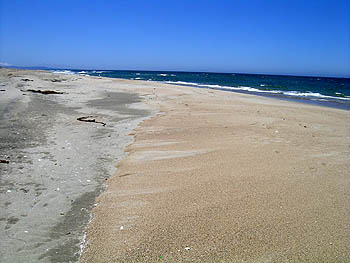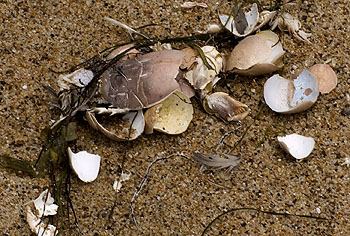
|
|||||||||||||||
|
| |||||||||||||||
Spring winds and waves rebuild beaches and dunes In May, the Central Coast beaches are actively rebuilding from winter storms with the help of small waves (which move the sand from offshore to the beach) and strong afternoon winds (which move the sand from the foreshore to the back of the beach and dunes).
 As spring progresses, smaller waves carry sand toward shore in waves (also known as sand bars). When one of these "waves" of sand arrives at the beach, it merges on to the existing beach. In this photo, you can see where a large wave of sand has flowed over the low, winter beach (fine gray sand) in a layer of coarse, reddish-brown sand. (Source: Kim Fulton-Bennett) By May, the large, long-period north swells of winter are pretty much over. However, strong northwest winds blowing just off the coast (both locally and off Northern California and Oregon) sometimes create short-period wind waves that can be relatively large (8-10 feet). In addition, "fall" storms in the Southern Pacific Ocean can generate long-period waves that reach south-facing beaches. During periods when wind-waves are relatively small (3-6 feet), sand begins to move from offshore sand bars toward the beach. When one of these "waves" of sand arrives at the beach, it "welds" onto the existing beach, making it a little bit wider. High tides push the sand over the beach crest (the "berm"), making the beach higher as well. You can sometimes tell when one of these beach-widening events has occurred because the new beach sand is often coarser than the older sand. On some beaches, this newly deposited sand will be orange or pink in color because it contains grains of a pinkish mineral called feldspar. The new beach sand may also contain deposits of sea shells, sand dollars, mole crab shells, by-the-wind sailors, or other bits flotsam. Strong spring winds also help the beach build up. Gusty afternoon winds pick up the smaller sand grains and carry them toward the back of the beach. On beaches with sand dunes, this wind-driven sand helps rebuild parts of the dunes that were eroded by winter storm waves. The wind often deposits sand around bits of seaweed or driftwood on the upper beach, creating small localized dunes. With the help of beach hoppers, flies, beetles, and other insects, the beach wrack begin to decompose and add organic matter to the sand. Dune plants, such as sea rocket, sprout in the organically enriched areas, and help hold the sand in place. In general, beach plants are most likely to expand and colonize new areas during years when there is plenty of rain between February and May and when spring winds are not too strong and continuous. Dune and beach plants These plants often start blooming in April or May and continue into the summer, depending on amount of water available from late spring rains and coastal fog. Throughout the spring and summer, periods of larger wind-waves may erode sand from the berm and carry it offshore, away from the beach. However these waves do not usually move sand into deep water, outside the main surf zone, as winter waves do. Also beach erosion from short-period winds waves rarely reaches the back of the beach or dunes, so these areas may continue to rebuild throughout the spring. Excirolana isopods carry eggs  Beach wrack and molted mole-crab carapaces-perfect food for Excirolana isopods. (note spiny mole crab carapace at middle top (Source: Kim Fulton-Bennett) Nestled within the grains of sand on the rebuilding beaches are 1/4-inch-long, multi-legged Excirolana isopods. Like their tide-pool-dwelling relatives, these beach isopods typically carry eggs in brood pouches from April through June. The female isopods release their young at the highest spring tides. Carried on the tide, the young swim out into the surf zone and begin feeding. After mole crabs, Excirolana isopods are probably the most common and ecological important animals living in the "swash zones" of sandy beaches. Marine biologists have counted more than 800 of these tiny isopods in a single square meter of sand. They are also important as food for surf perch and small, scurrying beach birds such as sanderlings. Excirolana isopods eat mostly dead mole crabs and mole-crab eggs, so you can usually find them in the same areas as mole crabs. At low tide, you may find the isopods burrowed about 1/4 inch below the surface of the wet sand (you will need a good hand lens to see them because they are so tiny). At high tides the isopods swim around in the waves looking for cast off mole crab skeletons and other debris. Excirolana isopods will eat the dead or dying flesh of many other organisms besides mole crabs. According to one observer, they will "vigorously attack any animal material encountered." So if you are ever walking in the shallow water of a sandy beach and feel something tiny nibbling at your toes, it might be a swarm of isopods. Snowy plovers nest locally Snowy plovers (Charadrius alexandrinus nivous) are the only species of shore bird that commonly nests on Central Coast beaches. Unfortunately, these tiny birds must share their nesting areas with large numbers of clueless humans and their canine and equine companions. At first glance, snowy plovers look somewhat like sanderlings and sandpipers, but at six inches from beak to tail tip, they are even smaller than these other beach birds. Snowy plovers' most distinguishing marks are a black line through each eye and a black patch on each shoulder. The black shoulder patch always reminds me of an old-fashioned, starched bow-tie that has come undone. You are most likely to see snowy plovers feeding along the dry upper portions of remote Central Coast beaches that are backed by sand dunes. Unlike sandpipers, snowy plovers don't run continuously back and forth with the waves, but make short dashes across the sand, then freeze. If frightened, they often run up the beach instead of down toward the water, like sanderlings. When running, snowy plovers look very much like pieces of kelp or other beach debris blowing in the afternoon sea breeze. When resting or nesting, snowy plovers blend in so well with their surroundings that they become practically invisible. The little birds often crouch in small depressions in the sand for protection from April's howling sea breezes. Even tire tracks or human footprints are deep enough to provide a modicum of shelter for these tiny birds. In March or April, snowy plovers return to the Central Coast from their winter feeding grounds in the Great Plains and other inland areas. Groups of plovers often nest along the same stretch of beach each year. From March through September, they build nests in the most exposed locations imaginable, laying eggs in shallow depressions in the sand, amidst the kelp wrack and driftwood, and just above the high tide line. Female snowy plovers lay one to three eggs in a clutch. Exposed to the howling northwest winds, these eggs would only survive for an hour or two without a parent bird sitting on them to keep them warm. During the daytime, female plovers incubate the eggs while the males forage for food. At night they trade places. Unfortunately, many of the beaches where snowy plovers nest are also very popular with humans during the summer months. Because snowy plover eggs and nests are so tiny and well camouflaged, it is very easy for humans to walk past nests or even step on them without even noticing. Even seemingly innocuous human activities, such as sunbathing, camping, picnicking, playing catch, or flying kites can frighten snowy plovers from their nests. At first the nesting plover may try to chase or lure the human intruder away from its nest. If this doesn't work, the bird will leave its nest and will not return until the intruder is at least 300 feet away. This leaves the plover's eggs exposed to the cold wind, as well as to predators such as dogs, gulls, crows, ravens, skunks, and foxes. If a snowy plover's eggs are not stepped on, abandoned, or eaten, the young will hatch in about 27 days. Within a few hours of hatching, the young downy chicks will be dashing across the sand on spindly little legs, hunting for insects and beach hoppers. In another month, the young plovers will be on their own, and the female plover may try to nest again. In August or September, most plovers will leave the Central Coast and fly back to their winter feeding areas. |
